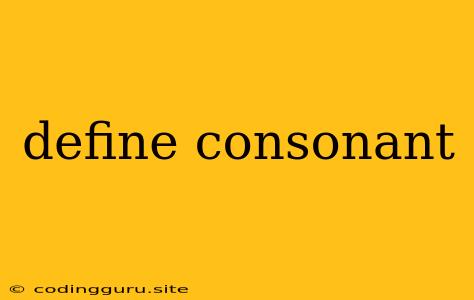What are Consonants?
The world of language is built on the sounds we make, and these sounds are classified into different categories to better understand how they work. One of these important categories is consonants. But what exactly are consonants?
Consonants are sounds produced by partially or completely obstructing the flow of air from your lungs through your mouth or nose. This obstruction can be created in different ways, resulting in the diverse range of consonant sounds we use in speech.
How do Consonants Differ from Vowels?
While consonants are characterized by airflow obstruction, vowels are produced with an open vocal tract, allowing air to flow freely. You can feel the difference by saying the vowel "a" and then the consonant "m." With "a," your mouth is open and the air flows freely, while with "m," your lips are closed, creating an obstruction.
What Makes a Consonant a Consonant?
Let's delve deeper into the characteristics that define consonants:
- Obstruction of Airflow: As we mentioned earlier, consonants are created by obstructing the flow of air from your lungs. This can be done by:
- Closing your lips completely: Like in the sounds "p" and "b."
- Partially closing your lips: As in the sounds "f" and "v."
- Using your tongue to touch the roof of your mouth: This happens in sounds like "t," "d," "k," and "g."
- Using your tongue to create a narrow passage: This is how sounds like "s" and "sh" are produced.
- Place of Articulation: The point in your mouth where the airflow is obstructed is called the "place of articulation." The location of this obstruction plays a crucial role in determining the sound of the consonant. For example, the sounds "p" and "b" are both made with closed lips, while "t" and "d" are produced with the tongue touching the ridge behind your teeth.
- Manner of Articulation: This refers to how the air is obstructed. The different ways of obstructing airflow lead to the various consonant sounds we hear. Examples include:
- Stops: These consonants are formed by completely blocking the airflow and then suddenly releasing it. Examples: "p," "b," "t," "d," "k," and "g."
- Fricatives: These consonants are produced by creating a narrow opening in the mouth and forcing air through it. Examples: "f," "v," "s," "z," "sh," and "zh."
- Affricates: These consonants combine a stop and a fricative. Examples: "ch" (as in "chair") and "j" (as in "jump").
- Voicing: This refers to whether the vocal cords are vibrating or not during the production of the consonant. Consonants can be voiced or voiceless. Voiced consonants vibrate the vocal cords, while voiceless consonants do not. Examples: "b" and "p" are both made with closed lips, but "b" is voiced and "p" is voiceless.
Why are Consonants Important?
Consonants play a vital role in language:
- Structure of Words: They provide the framework for words, giving them their shape and form.
- Clarity of Speech: Consonants help differentiate words and convey meaning. Imagine trying to understand a sentence without any consonants, it would be almost impossible!
- Intonation and Emphasis: Consonants can change the intonation and emphasize certain words, adding meaning and expression to our speech.
Examples of Consonants
Here are some examples of consonants in the English alphabet:
- Stops: "p," "b," "t," "d," "k," "g"
- Fricatives: "f," "v," "s," "z," "sh," "zh"
- Affricates: "ch," "j"
- Nasals: "m," "n," "ng"
- Liquids: "l," "r"
- Glides: "w," "y"
Recognizing Consonants in Different Languages
The classification of consonants might vary across different languages. However, the core principles of airflow obstruction, place of articulation, and manner of articulation remain crucial in understanding the sounds of any language.
Conclusion
Consonants are fundamental building blocks of speech, contributing to the clarity, structure, and expression of language. Understanding how consonants are produced and their characteristics helps us appreciate the complexity and beauty of human communication.
